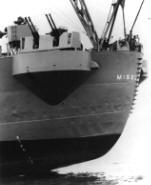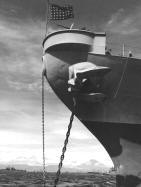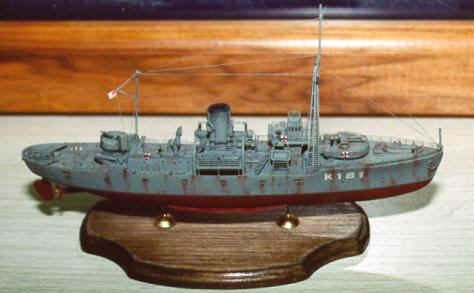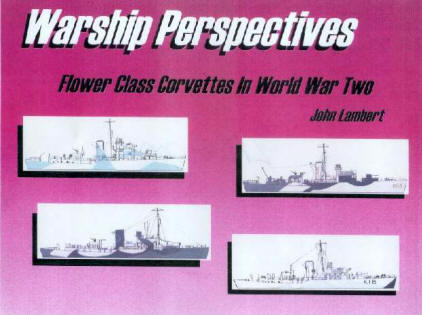Great Britain's shipbuilding
program of 1939 and 1940 required a convoy escort vessel which was capable of being built
quickly, of mounting the then available anti-submarine equipment, of surviving the heavy
seas around the British Isles, and of matching U-boat speeds. The design adopted was based
upon a whale-catcher built in Middlesbrough. 145
of these Flower-class corvettes were eventually built in the UK and they, led by a few
non-fleet destroyers, formed the bulk of the escorting warships which fought the battle of
the Atlantic. Their short length and shallow draught made them uncomfortable ships to
live in; even when they were modified, after the fall of France, to enable them to counter
the extended range of the German 'Wolf-packs'. A fortnight of constant rolling and
pitching on transatlantic convoy duty tended to exhaust all who sailed in them.
The ratings in the crews were mostly reservists with only a few key positions, such as
Cox'n, Chief Bos'n's mate, Gunlayer, Chief Engineer etc., being filled by regular or
recalled personnel; the officers were reservists, almost without exception, with the
Captain usually ex-merchant navy.
Service aboard was monotonous and debilitating for long periods, either because of the
need for constant vigilance in the face of those twin dangers, the sea and the enemy, or
because of, in the North Atlantic at least, the cold. When action came, it could be
prolonged and brutal with the sight and aftermath of the sinking of freighters or of other
warships. The torpedoing of a corvette itself would be especially dramatic: its few
compartments below the water line would cause it to sink in seconds, with few survivors.
Over 20 corvettes fell victim to torpedo or mine during the War.
Normally sleeping conditions on board for officers and petty officers were relatively
reasonable, but for the seamen in a crowded, stuffy and water laden forecastle they were a
great hardship. The inability to store perishable food for more than 2 or 3 days led to a
boring repetition of corned-beef and powdered potato for breakfast, lunch and dinner.
Since most of the crewmen were young, persistent sea-sickness was the principal
health-hazard. Home-leave was possible only when the ship was refitting or cleaning
boilers, but local leave was liberally granted on both sides of the ocean at the end of
convoy duties. After the Normandy landings in 1944, the Flower-class gave way in the
Atlantic to the newer and faster frigates and Castle-class corvettes.
Canadian Navy Flower class corvettes (80)
HMCS Agassiz, HMCS Banff, HMCS Chilliwack, HMCS Trail,
HMCS Alberni, HMCS Edmunston, HMCS Nanimo, HMCS Timmins,
HMCS Vancouver, HMCS Algoma, HMCS Cobalt, HMCS Kamsack,
HMCS Kenogami, HMCS Morden, HMCS Oakville, HMCS Port Arthur,
HMCS Rosthern, HMCS Weyburn, HMCS Amherst, HMCS Sackville,
HMCS Moncton, HMCS Arrowhead, HMCS Bittersweet, HMCS Calgary,
HMCS Camrose, HMCS Dunvegan, HMCS Fennel, HMCS Fredericton,
HMCS Regina, HMCS Sherbrooke, HMCS Sorel, HMCS Arvida,
HMCS Louisberg, HMCS Matepedia, HMCS Summerside,
HMCS Ville de Quebec, HMCS Baddeck, HMCS Brandon,
HMCS Buctouche, HMCS Hepatica, HMCS Lunenburg, HMCS Levis,
HMCS Pictou, HMCS Rimouski, HMCS Shawinigan, HMCS Shediac,
HMCS Snowberry, HMCS
Spikenard, HMCS Windflower, HMCS Kitchener
HMCS Barrie, HMCS Battleford, HMCS Collingwood, HMCS Drumheller,
HMCS Galt, HMCS Halifax, HMCS Moosejaw, HMCS Orilla,
HMCS The Pas, HMCS Woodstock, HMCS Brantford, HMCS Midland,
HMCS Chambly, HMCS Chicoutimi, HMCS Dauphin, HMCS Eyebright,
HMCS Lethbridge, HMCS Mayflower, HMCS Saskatoon, HMCS Trillium,
HMCS Charlottetown, HMCS Napanee, HMCS Prescott, HMCS Sudbury,
HMCS La Malbaie, HMCS Dawson, HMCS Dundas, HMCS Kamloops,
HMCS New Westminister and HMCS Quesnell
Modified Canadian Navy Flower class corvettes (45)
HMCS Burnet, HMCS Charlock, HMCS Forest Hill, HMCS
Asbestos,
HMCS Atholl, HMCS Beauharnois, HMCS Hawkesbury, HMCS Lachute,
HMCS Louisburg, HMCS Mandrake, HMCS Milfoil, HMCS Musk,
HMCS Nepta, HMCS Norsyd, HMCS Privet, HMCS Riviere de Loup,
HMCS St. Lambert, HMCS Stellarton, HMCS Merratonia, HMCS
Belleville,
HMCS Flax, HMCS Frontenac, HMCS Honesty, HMCS Peterborough,
HMCS Rosebay, HMCS Smith Falls, HMCS Trentonian, HMCS Coburg,
HMCS Linaria, HMCS Lindsay, HMCS Parray Sound,
HMCS Strathroy, HMCS Thorlock, HMCS West York,
HMCS Whitby, HMCS Willowherb, HMCS Comfrey, HMCS Cornel,
HMCS Dittany, HMCS Fergis, HMCS North Bay, HMCS Owen Sound,
HMCS Guelph, HMCS Smilax and HMCS Statice




